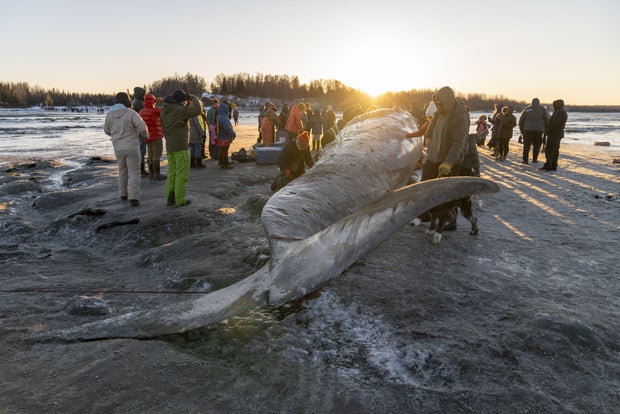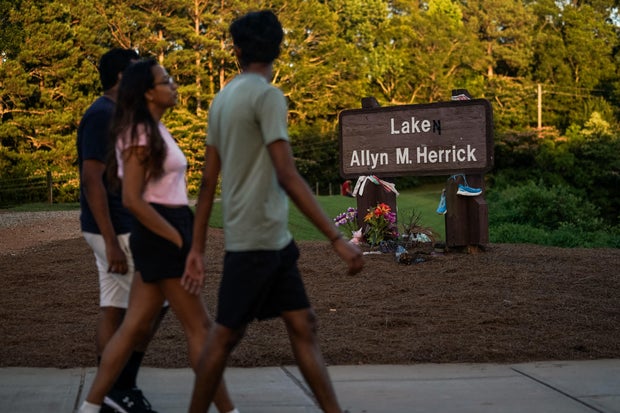CBS News
CMT Music Awards winners list for 2024: Live updates

Country music’s biggest stars have gathered to honor the best in country music videos and television performances at the 2024 CMT Music Awards.
Kelsea Ballerini, who is returning to host the ceremony for the fourth time, Lainey Wilson, Megan Moroney, Cody Johnson and Jelly Roll came into the night tied for the most nominations, with three each.
CMT Music Award winners are determined entirely by fan vote, and voting for the video of the year award remains open throughout Sunday night’s show. There were originally 16 nominees announced for video of the year, but on April 1 the field was whittled down to six, based on voting. The final three nominees — Johnson, Jelly Roll and Ballerini — were announced on the day of the show.
The show is once again being held in Austin, Texas, at the Moody Center. It is being broadcast on CBS television stations and streaming live on Paramount+.
Below is the full list of winners and nominees:
Collaborative video of the year
- Carly Pearce feat. Chris Stapleton — “We Don’t Fight Anymore” — Winner
- Ella Langley feat. Koe Wetzel — “That’s Why We Fight”
- Jon Pardi and Luke Bryan — “Cowboys And Plowboys”
- Justin Moore and Priscilla Block — “You, Me, & Whiskey”
- Lukas Nelson & Promise of the Real feat. Lainey Wilson — “More Than Friends”
- Mickey Guyton feat. Kane Brown — “Nothing Compares To You”
- Old Dominion feat. Megan Moroney — “Can’t Break Up Now”
CBS News
Woman linked to 14 cyanide murders is convicted and sentenced to death in Thailand

A Thai woman believed to be among the worst serial killers in the kingdom’s history was convicted and sentenced to death Wednesday for poisoning a friend with cyanide, in the first of her 14 murder trials.
Sararat Rangsiwuthaporn, 36, an online gambling addict, is accused of swindling thousands of dollars from her victims before killing them with the chemical.
A court in Bangkok convicted her Wednesday for fatally poisoning her friend Siriporn Kanwong.
The two met up near Bangkok in April last year to release fish into the Mae Klong river as part of a Buddhist ritual.
Siriporn collapsed and died shortly afterwards and investigators found traces of cyanide in her body. Last year, police said they collected fingerprints and other evidence from Sararat’s Toyota Forerunner.
LILLIAN SUWANRUMPHA/AFP via Getty Images
Police were then able to link Sararat to previously unsolved cyanide poisonings going back as far as 2015, officers said.
“The court’s decision is just,” Siriporn’s mother, Tongpin Kiatchanasiri, told reporters following the verdict. “I want to tell my daughter that I miss her deeply, and justice has been done for her today.”
Police said Sararat funded her gambling addiction by borrowing money from her victims — in one case as much as 300,000 baht (nearly $9,000) — before killing them and stealing their jewelry and mobile phones.
She lured 15 people — one of whom survived — to take poisoned “herb capsules,” they said.
Sararat faces 13 more separate murder trials, and has been charged with around 80 offenses in total.
Her ex-husband, Vitoon Rangsiwuthaporn — a police lieutenant-colonel — was given 16 months in prison and her former lawyer two years for complicity in Siriporn’s killing, the lawyer for the victim’s family said.
The couple, while divorced, had still been living together, the BBC reported. Police said Rangsiwuthaporn was likely involved in Sararat’s alleged murder of an ex-boyfriend, Suthisak Poonkwan, the BBC reported. Police said that after she killed him, Rangsiwuthaporn picked her up in her car and helped her extorte money from Suthisak’s friends.
Thailand has been the scene of several sordid and high-profile criminal cases.
Earlier this year, six foreigners were found dead in a luxury Bangkok hotel after a cyanide poisoning believed to be connected to debts worth millions of baht.
CBS News
Endangered fin whale measuring nearly 50 feet found dead near Anchorage, drawing curious onlookers to beach

An endangered fin whale that washed up near a coastal trail in Alaska’s largest city has attracted curious onlookers while biologists seek answers as to what caused the animal’s death.
The carcass found over the weekend near Anchorage was 47 feet (14.3 meters) long – comparable to the width of a college basketball court – and female, according to National Oceanic and Atmospheric Administration biologists.
Barbara Mahoney, a NOAA biologist examining the whale, told the Anchorage Daily News the whale was likely 1 to 3 years old.
Fin whales are the second-largest whale species, according to NOAA Fisheries, and fully grown can reach up to 85 feet long and weigh between 40 tons and 80 tons. Strikes by ships, entanglements in fishing gear, underwater noise and the effects of climate change are among the threats that fin whales face, according to the agency.
Hasan Akbas/Anadolu via Getty Images
Mandy Keogh, a NOAA marine mammal stranding coordinator, said fin whales generally aren’t seen this close to Anchorage and that recent high tides may have pushed the animal further into the Knik Arm.
People trekked across the mudflats to see the whale, which NOAA biologists and staff from Alaska Veterinary Pathology Services had anchored to the shore Sunday so they would be able to gather samples from the animal. But even after samples are analyzed, it can be difficult to determine a cause of death because of decomposition or a lack of obvious injuries, Keogh said.
Daisy Grandlinard was among the parents who accompanied a group of children to see the whale Monday. As they drew closer, they could smell it, she said.
“It was really interesting for the kids to be able to feel it, touch the bottom because it kind of had tracks on it, like a sled almost. And just to see the size of it, that was pretty cool,” she said. “We had already studied whales a couple of weeks ago, so it was fun to see one in person and say, ‘Oh, that’s what the baleen looks like in real life,’ and ‘Where is the blow hole?’ “
Biologists hoped to complete their work Tuesday, untether the carcass and “let the tide push it or move it,” Mahoney said. “Whatever it does or doesn’t do – we don’t know.”
According to NOAA, the whaling industry killed nearly 725,000 fin whales in the mid-1900’s in the Southern Hemisphere alone. Today, the major threat to the species comes from vessel strikes.
Other fin whales have washed ashore along the Western U.S. this year. In August, a large fin whale washed ashore in Southern California and died before rescuers could get to the scene, CBS Los Angeles reported. Officials said the whale, which was not fully grown, was believed to be in poor health due to visible bumps on its skin and a thin build.
In February, a 46-foot-long whale was found washed up on an Oregon shore — emaciated, entangled and covered in what appears to be wounds from killer whales.
CBS News
How Laken Riley’s death sent “a reality shock” through the college town of Athens, Georgia

Just two blocks from the University of Georgia campus, in a downtown courtroom in Athens, Georgia, Jose Ibarra is on trial for the murder of 22-year-old Laken Riley, a former UGA student who transferred to the nursing program at Augusta University’s Athens campus.
In late February, Riley was attacked during her morning jog on a trail near the University of Georgia’s intramural fields. As the investigation and trial unfolded, members of the Athens community grappled with a shaken sense of security.
“Just because we’re on campus doesn’t mean, necessarily, that the bad parts of the world can’t get in,” said Allison Mawn, a fourth-year student. “She did everything right. She told friends where she was going, she went on a popular trail during the day. She had her tracking location on. She even managed to call for help, and still it wasn’t enough.”
The case was thrust into the national spotlight when authorities arrested Ibarra, an undocumented Venezuelan immigrant who entered the country two years ago, and charged him with murdering Riley. In the midst of the election cycle, her death quickly became a flashpoint in the immigration debate, with former President Donald Trump and his supporters raising it at rallies and President Biden responding to heckling about it in his State of the Union address.
“In an instant, all the eyes across the country are on us,” said Mawn. “Now you can’t say the name Laken Riley without thinking about undocumented immigrants and illegal immigration.”
ELIJAH NOUVELAGE/AFP via Getty Images
Students have organized vigils and prayer groups, and participated in protests, rallies and runs in memory of Riley. A GoFundMe set up by her family amassed over $250,000 in donations that will go to the Laken Hope Foundation, an organization that will “promote safety awareness for women, aid and tuition assistance for nursing students, and children’s healthcare… all causes that Laken felt strongly about.”
For many students, Athens no longer feels like the safe haven they once thought it was. To ease fears, University of Georgia President Jere Morehead announced a $7.3 million campus safety initiative. The campus has been fortified by an expanded university police force, hundreds of additional lights and security cameras and multiple emergency call stations and license plate readers.
ELIJAH NOUVELAGE/AFP via Getty Images
Over the past months, “there was an expectation that we would magnify those efforts,” said P. Daniel Silk, the University of Georgia’s associate vice president for public safety. “We want to be more safe and more secure tomorrow than we were yesterday.”
While the Athens community waits for justice to be delivered, students bustle around campus, walking under the newly installed street lights, passing by additional emergency call systems and easing into a heightened security presence. Classes may go on, but the campus and community are changed.
“Regardless of what the verdict is, unfortunately we still lost a student. We still lost a life and nothing’s gonna change that,” said Mawn. “Things are never going to be a hundred percent the same for any of us here.”





